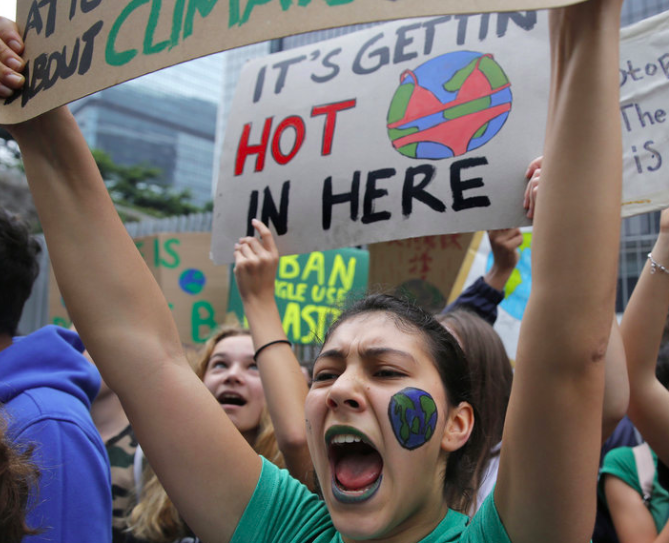
Amelia Benamara
Staff Writer
On March 15th the People’s Climate March was held in City Hall, where hundreds of students left school early to show their passion for the environmental change. Organizations Friends of the Earth and Plan B are challenging the government’s plans to expand climate change through gatherings such as the march.
The Climate Change protest involved students coming together to push elected officials towards creating policy changes regarding our treatment of the environment and the prevention of further climate change. Dozens of posters arose, visible with puns and quotes that reflected the level of worry by many individuals in the School District of Philadelphia.
The environment has been at risk for many years now, as we could see with the recent weather. In these most recent weeks, the SLA community has noticed a dramatic back and forth switch with the weather.
“I did my own research on climate and it scared me because there is so much talk about how many years left to live and how the Earth is no longer livable,” Junior Laila Kerbag expresses her fear.
Although some may be oblivious to the sudden changes, many students at SLA’s main campus are taking multiple actions to bring back the healthy Earth that once was.
“Honestly, I’m afraid for the future of our environment and am alarmed at how the problem is dismissed by people everywhere, whether that be government officials or just everyday people. Senior Olivia Musselman speaks upon her worries, “in America, we brush off the effects of climate change and plastic pollution because we often aren’t seeing those effects that much on our soil.”
It has reached the point in life where the climate change in our environment is completely noticeable as well as the ability to feel it happening around us. A number of SLA students have very strong opinions about the things they do personally to avoid these changes.
“There is plenty of factual, scientific evidence supporting that greenhouse gasses, plastic pollution, runoff, dumping, the overproduction of cattle, landfills, the release of greenhouse gasses from landfills, the textile industry, and a multitude of other things prove that humans are the cause of climate change and other negative changes in our environment,” Musselman expands on the scientific aspect.
The SLA body can see the differences and affects around us, as well as all over the world. Climate change is no longer just an “issue” that needs repairing before it damages us because as people are going about their daily lives, climate change is destroying our world.“
The younger generation, isn’t being informed enough about the matter. It affects their age groups most, because climate change is a slow process that will eventually affect their future. At SLA, students declare that the community doesn’t exactly do an acceptable duty of keeping up with climate change news and doing everything in their power to prevent it.
Like many are aware of, the school doesn’t recycle — rather they pay to do so. As a community, students and the faculty can do better considering we are in the heart of the city where the Climate March was held.
Although there was an acceptable amount of students who attended the walk out to show their support and dedication, there was a handle full of students who used the protest as an excuse to skip class rather than because than to show their support.
“The reason for skipping school and going to the strike was planning for a change that we may not have due to climate change,” Laila Kerbag stated, “everyone gathered around city hall with signs and a couple of people were speaking.”
As a community, the SLA center city campus needs to prioritize the environment’s health, as well as getting students used to taking care of the atmosphere.
“Students at SLA should push the district to provide recycling bins where students can sort out the trash into plastics, glass, and more. The faculty in the building should support the students as well as speak up the administration about energy efficient practices. And together, students, teachers, and administrators need to be on the same page to reduce a smaller ecological footprint at SLA,” stated science teacher Surinder Kaur.
Increasing mindfulness around sustainability is one change. Introducing a recycling system is a good idea, but ultimately, only 9% of trash is actually recycled (https://news.nationalgeographic.com/2017/07/plastic-produced-recycling-waste-ocean-trash-debris-environment/). With this being a proven fact, a student suggests a possible change the community can act upon.
“A better solution to that problem would be to try using more sustainable materials in our school, such as having teachers have all assignments online instead of on paper. In an ideal world, school lunches would be served on reusable plates with reusable utensils to reduce our use of styrofoam and plastics, but that requires more funding from the district,” says Olivia Musselman.
As we move forward, the smallest changes people make will implement a big change within the environment — even with it being a slow improvement.
Leave a Reply